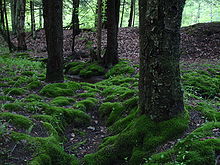**Botanical Characteristics**:
– Mosses are non-vascular plants in the division Bryophyta.
– They lack water-bearing xylem tracheids or vessels.
– Mosses absorb water and nutrients through their leaves.
– The dominant phase of the moss life cycle is the haploid gametophyte generation.
– Mosses reproduce using spores and do not produce seeds or flowers.
– Mosses have simple leaves composed of a single layer of cells with no internal air spaces.
– They have threadlike rhizoids that anchor them to substrates.
– Mosses can be distinguished from liverworts by their multicellular rhizoids.
– Sporophytes of mosses are short-lived and dependent on the gametophyte for water and nutrients.
**Reproductive Strategies**:
– Dioicous mosses have separate male and female plants.
– Monoicous mosses have both sexes on the same plant.
– Sperm with biflagellate swim to archegonia for fertilization.
– Some mosses use splash cups to propel sperm for fertilization.
– Moss sporophyte matures over several months after fertilization.
– Mosses like Ulota phyllantha produce gemmae for asexual reproduction.
– Gemmae can form new plants without fertilization.
– Asexual reproduction bypasses the need for fertilization cycle.
– Moss dwarf males grow from wind-dispersed male spores.
– Dwarf males are present in various moss lineages.
**Ecology and Habitat**:
– Mosses grow in cool, moist, shaded areas.
– They can adapt to various substrates like rocks, soil, tree trunks.
– Mosses are found in forests, streamsides, urban areas, and aquatic environments.
– Some moss species grow on trees but are not parasitic.
– Mosses require liquid water for fertilization and can survive desiccation.
– Boreal forest mosses host nitrogen-fixing cyanobacteria.
– Mosses play a crucial role in nitrogen cycling in boreal forests.
– Mosses release fixed nitrogen into the soil upon disturbances.
– Mosses benefit the ecosystem by distributing nutrients.
**Commercial Significance and Uses**:
– Mosses are a key component of peat, mainly from the genus Sphagnum.
– They are used for decorative purposes in gardens and floristry.
– Mosses have been traditionally used for insulation and liquid absorption.
– Mosses play a crucial role in habitat restoration and reforestation.
– Mosses are used in green roofs and walls for advantages like reduced weight loads and high drought tolerance.
– Mosses are used in bonsai to cover soil and enhance aesthetics.
– Mosses are commercially harvested for purposes like fuel and horticultural soil additives.
– Mosses have been historically used for medical purposes and as first-aid dressings.
**Genetic and Evolutionary Research**:
– Mycorrhizal genes in the common ancestor of land plants are linked to land colonization.
– Mosses have shown over 60 independent losses of stomata.
– Interaction with microbes drives plant evolution.
– Fungi-derived genomic regions in mosses may relate to antagonism towards fungi.
– Studies on the genetic and evolutionary aspects of mosses provide insights into their reproductive biology and adaptations to various environments.
Mosses are small, non-vascular flowerless plants in the taxonomic division Bryophyta (/braɪˈɒfətə/, /ˌbraɪ.əˈfaɪtə/) sensu stricto. Bryophyta (sensu lato, Schimp. 1879) may also refer to the parent group bryophytes, which comprise liverworts, mosses, and hornworts. Mosses typically form dense green clumps or mats, often in damp or shady locations. The individual plants are usually composed of simple leaves that are generally only one cell thick, attached to a stem that may be branched or unbranched and has only a limited role in conducting water and nutrients. Although some species have conducting tissues, these are generally poorly developed and structurally different from similar tissue found in vascular plants. Mosses do not have seeds and after fertilisation develop sporophytes with unbranched stalks topped with single capsules containing spores. They are typically 0.2–10 cm (0.1–3.9 in) tall, though some species are much larger. Dawsonia, the tallest moss in the world, can grow to 50 cm (20 in) in height. There are approximately 12,000 species.
| Moss Temporal range: Carboniferous–present
| |
|---|---|

| |
| Clumps of moss on the ground and base of trees in the Allegheny National Forest, Pennsylvania, United States | |
| Scientific classification | |
| Kingdom: | Plantae |
| Clade: | Embryophytes |
| Clade: | Setaphyta |
| Division: | Bryophyta Schimp. sensu stricto |
| Classes | |
| Synonyms | |
| |
Mosses are commonly confused with liverworts, hornworts and lichens. Although often described as non-vascular plants, many mosses have advanced vascular systems. Like liverworts and hornworts, the haploid gametophyte generation of mosses is the dominant phase of the life cycle. This contrasts with the pattern in all vascular plants (seed plants and pteridophytes), where the diploid sporophyte generation is dominant. Lichens may superficially resemble mosses, and sometimes have common names that include the word "moss" (e.g., "reindeer moss" or "Iceland moss"), but they are fungal symbioses and not related to mosses.
The main commercial significance of mosses is as the main constituent of peat (mostly the genus Sphagnum), although they are also used for decorative purposes, such as in gardens and in the florist trade. Traditional uses of mosses included as insulation and for the ability to absorb liquids up to 20 times their weight. Moss is a keystone genus and benefits habitat restoration and reforestation.
